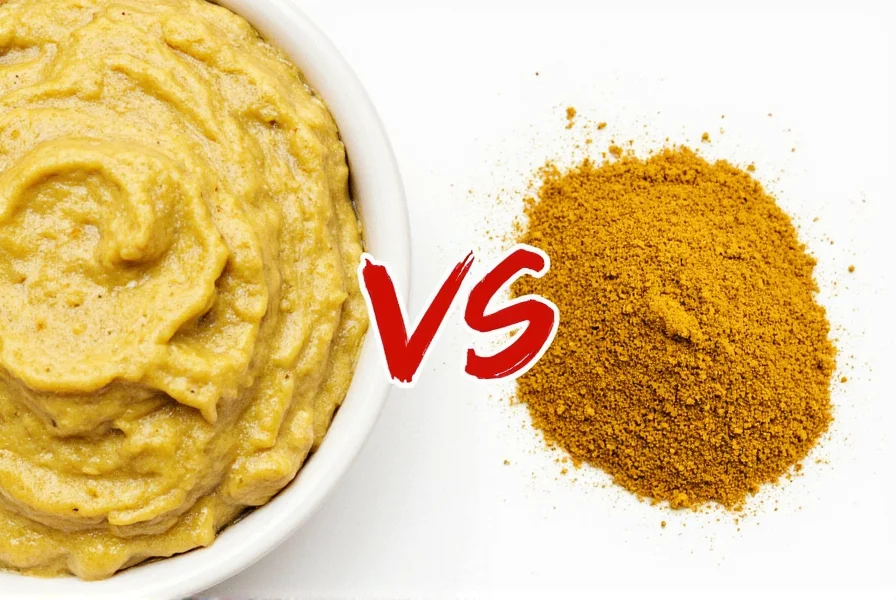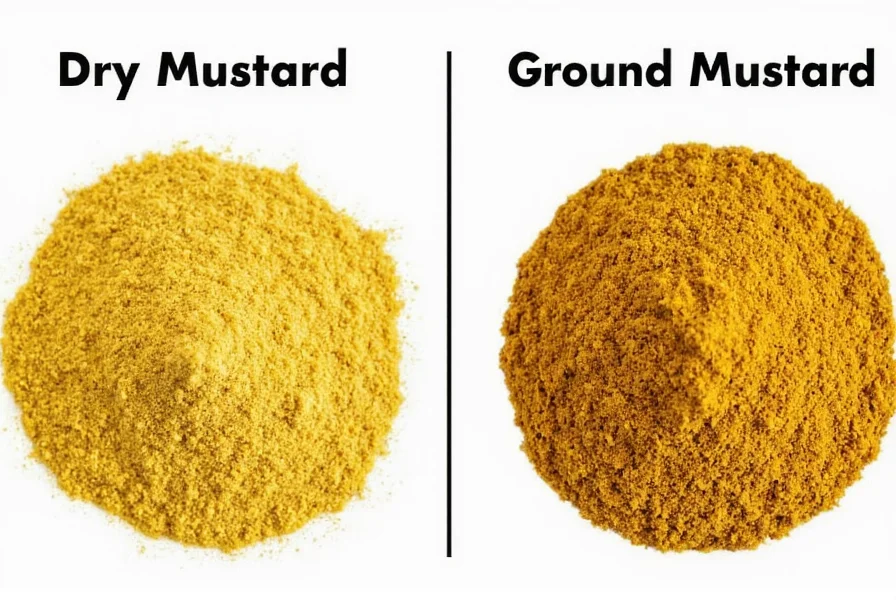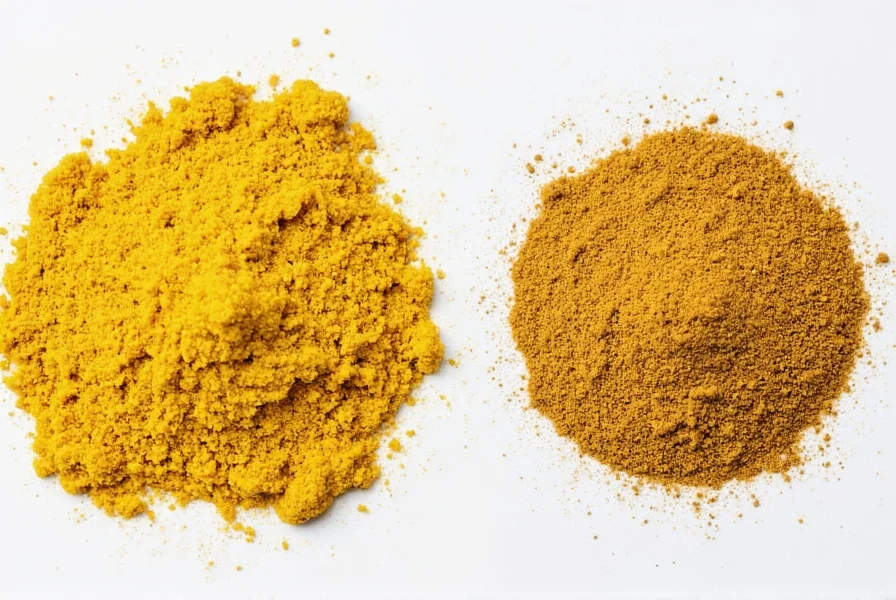Understanding the terminology around mustard products can prevent confusion in the kitchen. Many home cooks encounter recipes calling for “dry mustard” while their pantry contains “ground mustard,” leading to uncertainty about whether they can proceed without a special trip to the store. The good news is these terms are completely interchangeable in culinary contexts.
What Exactly Is Dry Mustard or Ground Mustard?
Dry mustard, also labeled as ground mustard, consists of mustard seeds that have been finely milled into a powder. This process removes the seed husks and creates a consistent, easy-to-measure spice. Unlike prepared mustard (the familiar yellow condiment), dry mustard contains no vinegar, water, or other liquids. It's a pure spice that activates when mixed with liquid during cooking.
The confusion between these terms largely stems from regional naming preferences and inconsistent labeling by manufacturers. Some spice companies use “dry mustard” to emphasize it's not the wet prepared version, while others use “ground mustard” to describe the physical form of the product. Neither term indicates a different product composition.
Dry Mustard vs. Other Mustard Products
Understanding how dry mustard differs from related products prevents recipe mishaps. The key distinctions lie in moisture content and preparation:
| Mustard Type | Composition | Common Uses |
|---|---|---|
| Dry/Ground Mustard | Pure ground mustard seeds (no liquid) | Baking, spice blends, marinades, cheese sauces |
| Prepared Mustard | Dry mustard + vinegar/water + spices | Sandwiches, hot dogs, salad dressings |
| Mustard Seeds | Whole yellow, brown, or black seeds | Pickling, tempering, homemade mustard |
| Mustard Powder | Synonym for dry mustard (sometimes includes turmeric) | Same as dry mustard |
Why Recipes Specify Dry Mustard
Chef-driven recipes often call for dry mustard because it provides precise flavor control. When you add dry mustard to a recipe, you determine the liquid ratio and activation time, which affects the final flavor profile. Prepared mustard introduces fixed ratios of vinegar and other ingredients that might alter a dish's intended balance.
For example, in cheese sauces or baked goods, dry mustard delivers that characteristic tang without thinning the mixture. In marinades, it creates a more intense mustard flavor as it hydrates slowly during the marinating process. Understanding how dry mustard activates in recipes helps explain why substitutions aren't always straightforward.
Substituting Between Mustard Forms
While dry mustard and ground mustard are identical, substituting other mustard forms requires adjustments:
- Dry mustard for prepared mustard: Use 1 teaspoon dry mustard plus 1 teaspoon liquid (water, vinegar, or wine) to replace 1 tablespoon prepared mustard
- Prepared mustard for dry mustard: Substitute 1 tablespoon prepared mustard for every 1 teaspoon dry mustard, but reduce other liquids by 2 teaspoons
- Mustard seeds for dry mustard: Grind 1.5 teaspoons mustard seeds to replace 1 teaspoon dry mustard (soak in liquid for 10 minutes first)
These substitutions work for most recipes, though dry mustard versus ground mustard in baking applications require particular attention to liquid ratios. In delicate batters or doughs, even small moisture changes can affect texture.
Storage and Shelf Life Considerations
Proper storage maintains the potency of dry mustard. Keep it in an airtight container away from light and heat. While whole mustard seeds remain potent for 3-4 years, ground versions lose flavor more quickly:
- Unopened dry mustard: 3-4 years
- Opened dry mustard: 1-2 years
- Signs of degradation: Faded yellow color, weak aroma, diminished heat
For best results in recipes requiring dry mustard powder substitution options, test older product by mixing a pinch with warm water—if it doesn't develop the characteristic pungent aroma within 30 seconds, it's time to replace it.
Common Culinary Applications
Dry mustard shines in applications where controlled flavor development matters. Classic uses include:
- Cheese sauces: Adds depth without thinning the sauce
- Barbecue rubs: Blends well with other dry spices
- Marinades: Activates slowly for deep flavor penetration
- Baking: Provides subtle tang in pretzels and certain breads
- Salad dressings: Creates emulsified dressings without separation
Professional chefs often prefer dry mustard in cooking with ground mustard techniques because it allows precise control over when the enzymatic reaction occurs that creates mustard's signature heat.

Addressing Common Misconceptions
Several myths persist about dry mustard that cause unnecessary confusion:
- Misconception: “Dry mustard contains additional ingredients.”
- Reality: Pure dry mustard contains only ground mustard seeds, though some commercial versions add turmeric for color
- Misconception: “Ground mustard is coarser than dry mustard.”
- Reality: Both terms describe the same fine powder; texture doesn't differ by name
- Misconception: “Dry mustard and mustard powder are different.”
- Reality: These are synonymous terms in culinary contexts
Understanding these facts eliminates confusion about is dry mustard the same as ground mustard in recipes and prevents unnecessary ingredient substitutions.

Final Clarification
When standing in your kitchen wondering are dry mustard and ground mustard the same thing, remember they're identical products with different labeling conventions. Check your spice cabinet—if you have either, you're ready to tackle any recipe calling for the other. The key distinction to remember is between these dry forms and prepared mustard condiments, not between the various names for the powdered spice itself.
Can I use ground mustard instead of dry mustard in a recipe?
Yes, ground mustard and dry mustard are identical products. You can use them interchangeably in any recipe without adjustment. The different names reflect regional labeling preferences, not product differences.
What's the difference between dry mustard and prepared mustard?
Dry mustard is pure ground mustard seeds with no liquid added, while prepared mustard contains dry mustard plus vinegar, water, and other ingredients. They cannot be substituted 1:1 without adjusting liquid ratios in recipes.
How much prepared mustard equals one teaspoon of dry mustard?
One teaspoon of dry mustard equals approximately one tablespoon of prepared mustard. However, when substituting, you should reduce other liquids in the recipe by two teaspoons to account for the moisture in prepared mustard.
Does dry mustard go bad?
Dry mustard loses potency over time but doesn't spoil. Properly stored in an airtight container away from light, it remains usable for 1-2 years after opening. Test older product by mixing with warm water—if it doesn't develop a strong aroma within 30 seconds, it's lost its potency.
Why do some recipes specifically call for dry mustard instead of prepared mustard?
Recipes specify dry mustard when precise control over flavor development and liquid content is important. Dry mustard allows chefs to determine exactly when and how the mustard's enzymes activate, creating more nuanced flavors in sauces, marinades, and baked goods without altering the recipe's moisture balance.
Frequently Asked Questions
- Can I use ground mustard instead of dry mustard in a recipe? Yes, they're identical products—use them interchangeably with no adjustments needed.
- What's the difference between dry mustard and prepared mustard? Dry mustard is pure ground seeds; prepared mustard contains vinegar and other liquids. They're not direct substitutes without adjusting liquid ratios.
- How much prepared mustard equals one teaspoon of dry mustard? Use 1 tablespoon prepared mustard for 1 teaspoon dry mustard, but reduce other liquids by 2 teaspoons.
- Does dry mustard go bad? It loses potency over 1-2 years but doesn't spoil. Test by mixing with warm water—if no strong aroma develops, replace it.
- Why do recipes specify dry mustard? For precise flavor control and to maintain exact liquid ratios in baking and sauce preparation.











 浙公网安备
33010002000092号
浙公网安备
33010002000092号 浙B2-20120091-4
浙B2-20120091-4